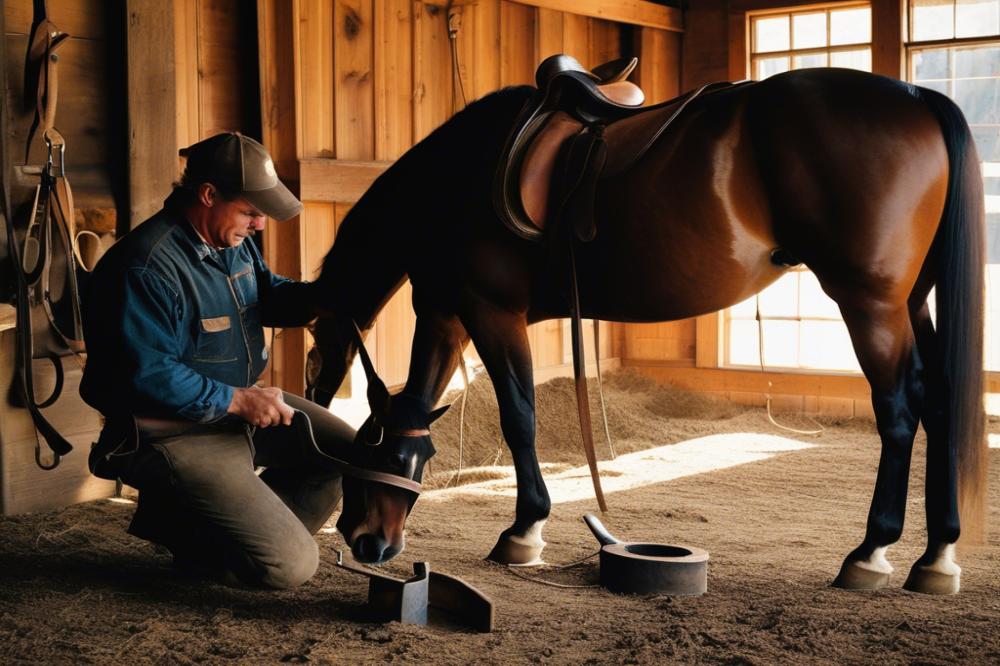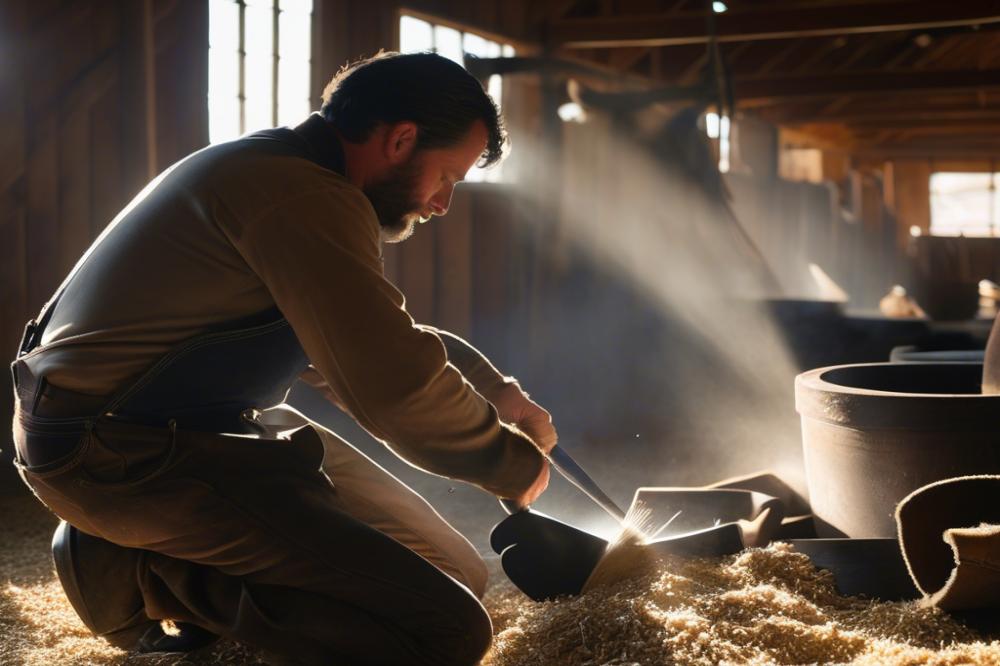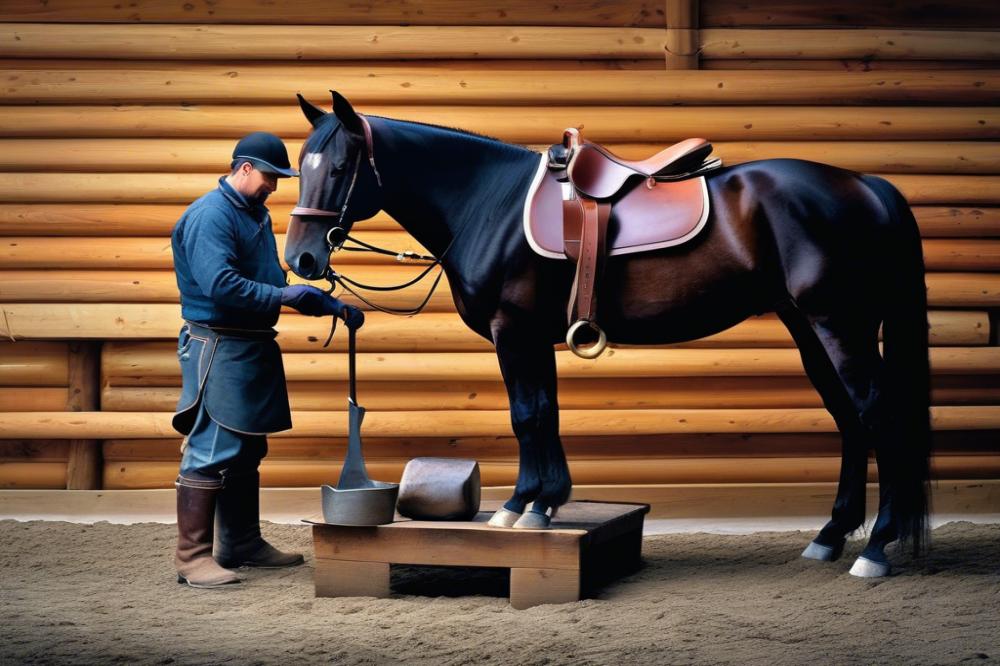Introduction
In the world of equine care, the role of a farrier is crucial. horses depend on proper hoof care for their overall health and performance. Hoof care is not just about keeping horses comfortable; it also affects their ability to compete and thrive in various equestrian disciplines.
horse shoeing is an art and a science. It requires specialized skills and knowledge. Many people do not realize that a horse’s hoof is complex. The structure of the hoof can impact everything from a horse’s gait to its speed. This is why farriers spend years training to understand the anatomy of the hoof and how to care for it effectively.
The connection between farrier work and the equestrian sport industry is significant. Without proper care and shoeing, horses may not perform at their best. This can lead to injuries or poor performance in competitions. For trainers and riders, a horse’s soundness is vital. It determines their ability to train and compete successfully.
In short, the significance of farrier services cannot be overstated. They are essential in promoting the health and athletic potential of horses. Well-cared-for hooves allow horses to navigate their environment more easily, whether on the farm or in a competitive arena. Understanding this relationship can help horse owners appreciate the skills and knowledge that farriers bring to the equine world.
The Role of the Farrier

A farrier plays a vital role in horse care. This skilled artisan not only shoes horses but also looks after their hoof health. Responsibilities vary from trimming hooves to applying horseshoes. A good farrier can diagnose hoof problems before they escalate.
Hoof care is crucial for a horse’s overall health. Healthy hooves support a horse’s weight and allow for proper movement. Neglected hooves can lead to lameness or more serious issues. Regular visits from a farrier help maintain hoof integrity and function.
Many wonder about the difference between a farrier and a blacksmith. Though both work with metal, their focus is different. A blacksmith primarily shapes metal for various tools and objects. In contrast, a farrier specializes in horse footwear and hoof care.
Overview of Farrier Techniques
Techniques utilized in shoeing horses vary based on individual needs. Some horses require standard shoes, while others benefit from specialized designs. Techniques also include corrective shoeing, which addresses specific hoof issues. When applied properly, these methods can enhance a horse’s performance.
Educating clients about hoof health is an important aspect of this trade. Many owners may not realize how much they impact their horse’s wellbeing. A farrier often advises on proper diet, exercise, and other factors. This ongoing communication fosters a better understanding of the horse’s needs.
Hoof Anatomy and Health

Basic Anatomy of the Horse Hoof
The horse hoof is a remarkable structure. It consists of various parts that work together to support the horse’s weight. The outer layer is called the hoof wall. This tough casing protects the softer structures inside. The sole, located on the bottom of the hoof, helps to absorb shock. The frog, a V-shaped structure, plays a critical role in circulation. Properly functioning hooves allow for graceful movement and stamina.
Common Hoof Problems and Their Impact on Horse Health
Many issues can affect hoof health. Thrush is a common condition that results in a foul-smelling infection. It occurs in the frog and can cause pain and lameness. Laminitis is another serious problem. This condition involves inflammation of the laminae, the tissues connecting the hoof wall to the bone. Severe cases can lead to long-term damage. Other issues include cracks, abscesses, and sore spots. Each problem can severely impact a horse’s overall health and performance.
Preventative Care and Maintenance Practices
Regular care is essential for healthy hooves. Routine inspections can help catch issues early. Keeping the hooves clean and dry minimizes the risk of infections. It is also important to provide a balanced diet. Nutrients like biotin promote healthy hoof growth. Regular trims help maintain the proper shape and length. Scheduling visits with a hoof care professional can also help detect problems before they escalate.
Understanding How Shoeing Tools and Techniques Help Treat and Prevent Issues
Various tools aid in hoof care. A hoof knife is used to remove dead tissue and debris. Rasps shape the hoof and smooth rough edges. Shoes can protect against certain conditions, especially in hard surfaces. Custom shoes may even correct issues such as imbalance or uneven wear. The right shoeing technique can also contribute to better circulation and comfort. Overall, these tools and methods help maintain hoof health and prevent future problems.
Farrier Education and Training
Pathways to Becoming a Farrier in the United States
To work as a farrier, one must undergo training. A few different paths exist for those wanting to enter this field. Many people choose formal education through specialized schools. These programs often last from several months to a couple of years. They provide hands-on experience and classroom instruction. Alternatively, some apprenticeships allow individuals to learn alongside experienced professionals. This method focuses on practical skills in real-world settings. Apprentices often receive guidance while working at stables or farms.
Overview of Farrier Schools and Apprenticeship Programs
Numerous schools offer programs for aspiring farriers. These institutions teach the science of hoof care and shoeing techniques. Students learn about anatomy and various hoof conditions. Some courses even cover business management for those wanting to run their own practice. Alongside these schools, many farriers accept apprentices. Working closely with a mentor allows a novice to gain invaluable experience. This hands-on training helps bridge the gap between theory and practice.
Essential Skills and Knowledge Required for Success
Successful farriers must develop a range of skills. Understanding horse behavior is vital. Additionally, knowledge of anatomy plays a significant role. Shoeing involves both art and science. Detailed attention is required to fit shoes correctly. Skills in forging and shaping metal come into play as well. Communication also becomes important when interacting with horse owners.
Continuing Education and Advancements in Farrier Techniques
The world of horse care is always evolving. New techniques and technologies emerge regularly. To stay relevant, continuing education is crucial. Many professionals attend seminars and workshops to enhance their knowledge. Advanced certifications are available and beneficial for career growth. Embracing these advancements can lead to better care for horses. Through continuous learning, farriers can provide the best services possible.
Tools of the Trade
The art of shoeing horses relies heavily on a specific set of tools. Each of these instruments plays a vital role in ensuring the horse’s comfort and performance. First, there are hoof knives, which help to trim the hooves and remove unhealthy tissue. Rasps are another essential tool; they shape and smooth the hooves, allowing for a proper fit of the shoe. Hoof pickers, though simple, are crucial for cleaning out debris that can cause discomfort.
Innovations in Farrier Equipment and Materials
Over the years, advancements in equipment have made shoeing more efficient. For example, modern hoof boots offer a lighter option compared to traditional metal shoes. These boots are removable, which can be a big plus for some horse owners. Newer materials like lightweight composites have also gained popularity. They provide strength while minimizing impact on the horse’s legs.
Comparison of Traditional Tools Versus Modern Technologies
When comparing old tools to modern options, differences are striking. Traditional tools have not disappeared; they still have their place. Some farriers prefer using handmade tools for their craftsmanship. Yet, modern technologies can enhance precision in shoe fitting. Electric tools are faster but require careful handling. Each approach has its advocates, often depending on personal preference and experience.
Importance of Proper Tool Maintenance in Farrier Work
Caring for tools is just as important as using them. A well-maintained hoof knife cuts more effectively and safely. Rusty rasps or dull files can lead to mistakes, which might cause pain for the horse. Regular cleaning and sharpening can extend the life of the tools. It is beneficial to inspect equipment frequently to identify any wear and tear. Proper maintenance creates a smoother workflow and enhances the quality of the shoeing process.
Farrier Techniques in Practice
Different horses require different shoeing techniques. Each equine has its own unique needs based on activity and health. Riders and owners often need to adapt their approach based on the horse’s environment. For example, a show jumper may benefit from lightweight shoes that provide spring. Meanwhile, a draft horse might need shoes designed to support heavy work.
Customization plays a vital role in shoeing performance horses. Equestrian sports demand precision. Custom shoes can improve the capabilities of these animals. Specialized shoes can promote better traction during competitions. A farrier must evaluate the horse’s conformation and specific requirements before making recommendations.
Best Practices for Livestock Management
Good hoof care is essential for overall health in horses. Monitoring the condition of the hooves should be a regular practice. Routine examinations can prevent many issues. Good practices include regular trimming and appropriate shoeing. Owners should work closely with professionals. They can provide insights into maintenance and proper care routines.
Using proper techniques helps promote soundness and performance. Understanding the relationship between hoof health and performance is important. A horse with neglected hooves may face numerous problems. Uneven wear can lead to lameness, which affects training and competition. Solid management ensures these animals stay healthy and perform at their best.
Knowledge of different materials for horseshoes is crucial. Options range from steel to aluminum, each offering its unique benefits. Some materials are lighter, while others provide excellent durability. A good understanding of these options can help achieve the desired outcome. Matching the shoe material to the horse’s specific activity can enhance performance.
Challenges Faced by Farriers
Being a farrier in the United States can be quite challenging. First, the profession is dealing with evolving standards for equine care. New veterinary practices often change how horses are managed. This requires constant learning and adaptation. Many farriers must update their skills regularly to remain relevant.
Economic factors also play a significant role. The cost of providing high-quality hoof care impacts pricing. Customers may struggle with increasingly high fees for services. In many cases, this can lead to difficult conversations about affordability. Farriers must balance their need for fair compensation with the client’s ability to pay.
There is also a noticeable skills gap within the profession. Many new entrants may not receive the training they need. This lack of experience can harm the overall quality of horseshoeing. Without proper skills, the well-being of horses may suffer. Experienced professionals often find themselves with extra responsibilities. Mentoring newcomers is necessary, but it takes time away from their own work.
On top of all this, marketing farrier services can be tough. The competition is intense, especially in urban areas. Many horse owners are unaware of how crucial a farrier is to equine health. Educating the public about these services is vital for success. Creating connections within the equine community can help build a loyal client base.
Seasonal changes also impact the demand for services. During the summer months, more horses are in active use. This increase can sometimes overwhelm a farrier’s schedule. On the flip side, winter may lead to less work. These fluctuations make financial planning difficult. Consistent income is often a struggle for these professionals.
Final Thoughts on the Craft of Equine Care
The role of a horseshoer is pivotal in maintaining the health and well-being of these remarkable animals. A farrier does more than just attach metal shoes. This craft combines veterinary knowledge with craftsmanship. Proper shoeing can prevent injuries and promote overall hoof health. Issues like laminitis or navicular disease can often be traced back to poor hoof care.
Adapting to new techniques and tools is essential in this profession. Technologies evolve, and understanding them is crucial for success. Continuous education keeps professionals abreast of developments. Workshops and seminars offer valuable insights into both traditional methods and modern innovations. Staying informed not only sharpens skills but also enhances the quality of equine care provided.
For those considering this pathway, know that it is both challenging and rewarding. The bond formed with horses can be incredibly fulfilling. Working with animals requires patience and a strong work ethic, but the rewards are substantial. Future horseshoers have the opportunity to make a lasting impact on the lives of numerous animals. With dedication and a thirst for knowledge, this career can become a lifelong passion.



